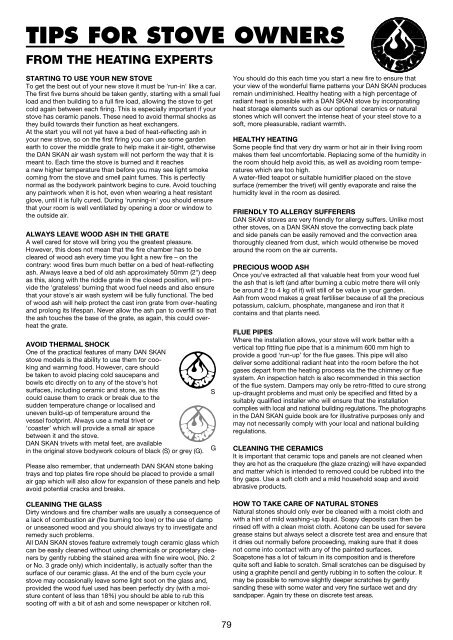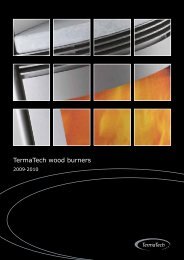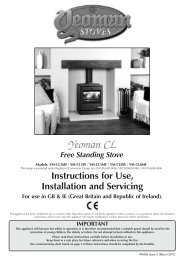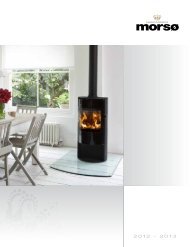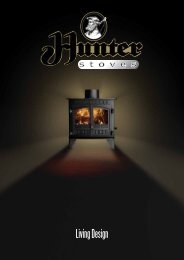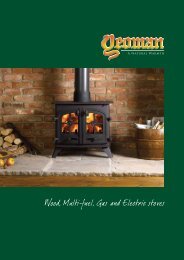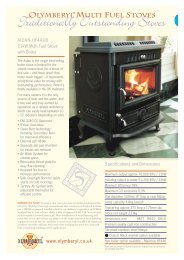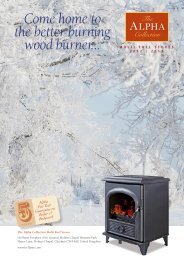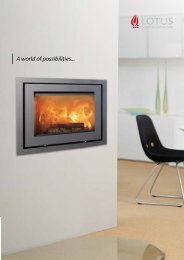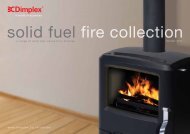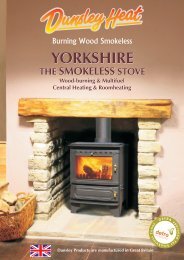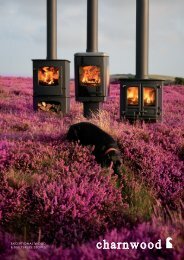Create successful ePaper yourself
Turn your PDF publications into a flip-book with our unique Google optimized e-Paper software.
TIPS FOR <strong>STOVE</strong> OWNERS<br />
FROM THE HEATING EXPERTS<br />
STARTING TO USE YOUR NEW <strong>STOVE</strong><br />
To get the best out of your new stove it must be 'run-in' like a car.<br />
<strong>The</strong> first five burns should be taken gently, starting with a small fuel<br />
load and then building to a full fire load, allowing the stove to get<br />
cold again between each firing. This is especially important if your<br />
stove has ceramic panels. <strong>The</strong>se need to avoid thermal shocks as<br />
they build towards their function as heat exchangers.<br />
at the start you will not yet have a bed of heat-reflecting ash in<br />
your new stove, so on the first firing you can use some garden<br />
earth to cover the middle grate to help make it air-tight, otherwise<br />
the Dan SKan air wash system will not perform the way that it is<br />
meant to. Each time the stove is burned and it reaches<br />
a new higher temperature than before you may see light smoke<br />
coming from the stove and smell paint fumes. This is perfectly<br />
normal as the bodywork paintwork begins to cure. avoid touching<br />
any paintwork when it is hot, even when wearing a heat resistant<br />
glove, until it is fully cured. During 'running-in' you should ensure<br />
that your room is well ventilated by opening a door or window to<br />
the outside air.<br />
ALWAYS LEAVE WOOD ASH IN THE GRATE<br />
a well cared for stove will bring you the greatest pleasure.<br />
However, this does not mean that the fire chamber has to be<br />
cleared of wood ash every time you light a new fire – on the<br />
contrary: wood fires burn much better on a bed of heat-reflecting<br />
ash. always leave a bed of old ash approximately 50mm (2") deep<br />
as this, along with the riddle grate in the closed position, will provide<br />
the 'grateless' burning that wood fuel needs and also ensure<br />
that your stove's air wash system will be fully functional. <strong>The</strong> bed<br />
of wood ash will help protect the cast iron grate from over-heating<br />
and prolong its lifespan. never allow the ash pan to overfill so that<br />
the ash touches the base of the grate, as again, this could overheat<br />
the grate.<br />
AVOID THERMAL SHOCK<br />
One of the practical features of many Dan SKan<br />
stove models is the ability to use them for cooking<br />
and warming food. However, care should<br />
be taken to avoid placing cold saucepans and<br />
bowls etc directly on to any of the stove‘s hot<br />
surfaces, including ceramic and stone, as this<br />
could cause them to crack or break due to the<br />
sudden temperature change or localised and<br />
uneven build-up of temperature around the<br />
vessel footprint. always use a metal trivet or<br />
‘coaster’ which will provide a small air space<br />
between it and the stove.<br />
Dan SKan trivets with metal feet, are available<br />
in the original stove bodywork colours of black (S) or grey (g).<br />
Please also remember, that underneath Dan SKan stone baking<br />
trays and top plates fire rope should be placed to provide a small<br />
air gap which will also allow for expansion of these panels and help<br />
avoid potential cracks and breaks.<br />
CLEANING THE GLASS<br />
Dirty windows and fire chamber walls are usually a consequence of<br />
a lack of combustion air (fire burning too low) or the use of damp<br />
or unseasoned wood and you should always try to investigate and<br />
remedy such problems.<br />
all Dan SKan stoves feature extremely tough ceramic glass which<br />
can be easily cleaned without using chemicals or proprietary cleaners<br />
by gently rubbing the stained area with fine wire wool, (no. 2<br />
or no. 3 grade only) which incidentally, is actually softer than the<br />
surface of our ceramic glass. at the end of the burn cycle your<br />
stove may occasionally leave some light soot on the glass and,<br />
provided the wood fuel used has been perfectly dry (with a moisture<br />
content of less than 18%) you should be able to rub this<br />
sooting off with a bit of ash and some newspaper or kitchen roll.<br />
S<br />
g<br />
79<br />
You should do this each time you start a new fire to ensure that<br />
your view of the wonderful flame patterns your Dan SKan produces<br />
remain undiminished. Healthy heating with a high percentage of<br />
radiant heat is possible with a Dan SKan stove by incorporating<br />
heat storage elements such as our optional ceramics or natural<br />
stones which will convert the intense heat of your steel stove to a<br />
soft, more pleasurable, radiant warmth.<br />
HEALTHY HEATING<br />
Some people find that very dry warm or hot air in their living room<br />
makes them feel uncomfortable. replacing some of the humidity in<br />
the room should help avoid this, as well as avoiding room temperatures<br />
which are too high.<br />
a water-filed teapot or suitable humidifier placed on the stove<br />
surface (remember the trivet) will gently evaporate and raise the<br />
humidity level in the room as desired.<br />
FRIENDLY TO ALLERGY SUFFERERS<br />
Dan SKan stoves are very friendly for allergy suffers. Unlike most<br />
other stoves, on a Dan SKan stove the convecting back plate<br />
and side panels can be easily removed and the convection area<br />
thoroughly cleaned from dust, which would otherwise be moved<br />
around the room on the air currents.<br />
PRECIOUS WOOD ASH<br />
Once you‘ve extracted all that valuable heat from your wood fuel<br />
the ash that is left (and after burning a cubic metre there will only<br />
be around 2 to 4 kg of it) will still of be value in your garden.<br />
ash from wood makes a great fertiliser because of all the precious<br />
potassium, calcium, phosphate, manganese and iron that it<br />
contains and that plants need.<br />
FLUE PIPES<br />
Where the installation allows, your stove will work better with a<br />
vertical top fitting flue pipe that is a minimum 600 mm high to<br />
provide a good ‘run-up’ for the flue gases. This pipe will also<br />
deliver some additional radiant heat into the room before the hot<br />
gases depart from the heating process via the the chimney or flue<br />
system. an inspection hatch is also recommended in this section<br />
of the flue system. Dampers may only be retro-fitted to cure strong<br />
up-draught problems and must only be specified and fitted by a<br />
suitably qualified installer who will ensure that the installation<br />
complies with local and national building regulations. <strong>The</strong> photographs<br />
in the Dan SKan guide book are for illustrative purposes only and<br />
may not necessarily comply with your local and national building<br />
regulations.<br />
CLEANING THE CERAMICS<br />
it is important that ceramic tops and panels are not cleaned when<br />
they are hot as the craquelure (the glaze crazing) will have expanded<br />
and matter which is intended to removed could be rubbed into the<br />
tiny gaps. Use a soft cloth and a mild household soap and avoid<br />
abrasive products.<br />
HOW TO TAKE CARE OF NATURAL STONES<br />
natural stones should only ever be cleaned with a moist cloth and<br />
with a hint of mild washing-up liquid. Soapy deposits can then be<br />
rinsed off with a clean moist cloth. acetone can be used for severe<br />
grease stains but always select a discrete test area and ensure that<br />
it dries out normally before proceeding, making sure that it does<br />
not come into contact with any of the painted surfaces.<br />
Soapstone has a lot of talcum in its composition and is therefore<br />
quite soft and liable to scratch. Small scratches can be disguised by<br />
using a graphite pencil and gently rubbing in to soften the colour. it<br />
may be possible to remove slightly deeper scratches by gently<br />
sanding these with some water and very fine surface wet and dry<br />
sandpaper. again try these on discrete test areas.


